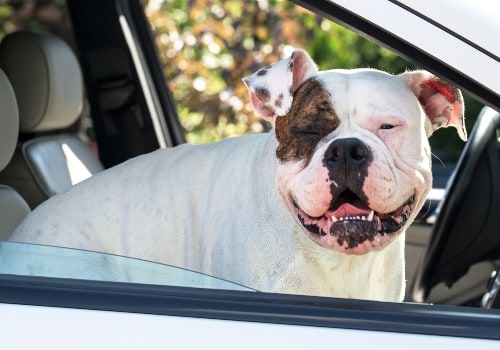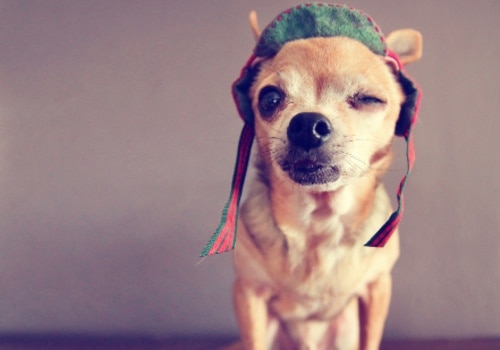We wink to communicate flirtatiousness, comedic intent, inside jokes and discreet greetings. But why do dogs wink — surely they’re not in on the same subtleties as us, right?
There’s no denying that it’s adorable when dogs wink, but try to analyze it any deeper and it just gets confusing. It’s just one of the many mysterious dog behaviors that we’re only just beginning to piece together.
But thanks to dog behaviorists and observant owners, there’s now a working theory behind dog winking. Let’s take a closer look!
Why Do Dogs Wink?

The Development of Facial Expressions
Before they were domesticated, dogs didn’t really use facial expressions to communicate (READ: Why do dogs paw at you?) very much. Sure, they would bare their teeth during fights or widen their eyes out of fear, but compared to us, their faces remained relatively stationary.
You can see evidence of this in wolves and other wild dogs. They rely far more on body language, scents and vocalizations than on facial expressions when communicating with one another.
But thousands of years ago, when humans and canines were still new arrivals in each other’s lives, a curious change began to take place.
Humans started taking an interest in the wolves that followed them around and ate their leftovers. Some wolves seemed braver than others and were more willing to get close to the humans, with the bravest among them accepting human touch without attacking.
These wolves were rewarded for their bravery with extra food scraps. Before long, humans and wolves began living peacefully alongside each other, with the humans providing food in exchange for the wolves’ protection.
Wolves were more likely to be accepted by humans if they were friendly and cooperative towards them.
In other words, wolves that behaved in more human-like ways towards humans were treated more favorably. That meant learning the ways humans acted and mimicking them — including using more dynamic facial expressions.
And thanks to the extra food they received, those wolves bred more and passed on those friendly genes to their offspring. Soon, they fully diverged from wild wolves and became domestic dogs.
Domestic Dogs and Eye Expressions
It’s clear that domestic dogs use more varied facial expressions than their wild counterparts. So where does winking come into play?
Well, it all starts with how dogs use their eyes to communicate with one another.
When two dogs stare at each other, it’s usually a sign that they’re not on the best of terms. Prolonged eye contact signifies wariness, distrust, and potential aggression — essentially, it’s a game of chicken.
By staring at one another, each dog hopes to convince the other to back off, lest a fight start. And if neither dog breaks eye contact, that’s exactly what will happen.
Now, that style of communication seems to work just fine for dogs. But when a dog tries to communicate with a human, it’s a different story.
When Dogs and Humans Lock Eyes
Humans don’t necessarily
This difference in communication can cause problems. Lock eyes with a dog for too long and you’re likely to get bitten, because dogs interpret your gaze as trying to start a fight.
But if you have a pet dog that you’re bonded with, he won’t want to fight with you even if you’re staring him down. So he may stare back for a little bit, then try to break the tension by looking away or winking.
This is an act of submission — a way of defusing what your dog interprets as a tense, potentially hostile situation.
No, he’s not being sassy, secretive, seductive or any of the other things we associate with winking. He’s trying to tell you that he knows you’re in charge and he’s not going to challenge your dominance.
Submission or Imitation?

But what about when your dog winks at you even when you haven’t been staring at him?
Well, remember how dogs evolved to behave in ways that appeal more to humans? Winking can also be related to that evolutionary drive to act like we do.
If you’re an expressive person who winks a lot, it’s possible that your dog has observed your behavior and taken note. It’s why he sleeps when you do, wants to eat when you do, and generally mirrors your movements and emotions.
So when your dog winks at you out of nowhere, he may simply be copying your actions. And when you smile, laugh or otherwise reward him for winking, you’re teaching him to continue imitating you — and that’s just what he’ll do.
Can Winking Be a Sign That Something’s Wrong?
Most of the time, winking is nothing to be worried about. But for certain dog breeds, it can be a sign of a more serious problem: entropion.
Dogs with entropion have eyelids that flip inwards towards the eye, causing discomfort, irritation and an irresistible urge to blink or wink. If left uncorrected, the rubbing of the eyelid on the surface of the eye can cause ulcers and vision problems.
Entropion is a hereditary disorder that typically affects puppies under 1 year of age. But it can happen to any dog of any age, especially after trauma or injury to the eye area.
Breeds with short noses and fleshy faces, such as Chow Chows and pugs, are more likely than others to develop entropion. However, many other breeds are susceptible to it as well, including golden retrievers, huskies, poodles and pit bulls.
Luckily, entropion is easily corrected with a series of two surgeries. The first surgery is more invasive and reverses the inward rolling of the eyelid, while the second is more minor and prevents the eyelid from rolling outward instead.
If the condition is corrected before the hairs on the eyelid damage the eye, there are no lasting effects and the dog will live a normal, healthy life.
However, most vets advise against performing the surgery until the dog has reached its full adult size. Complications can arise if the dog continues growing after receiving the surgery.
